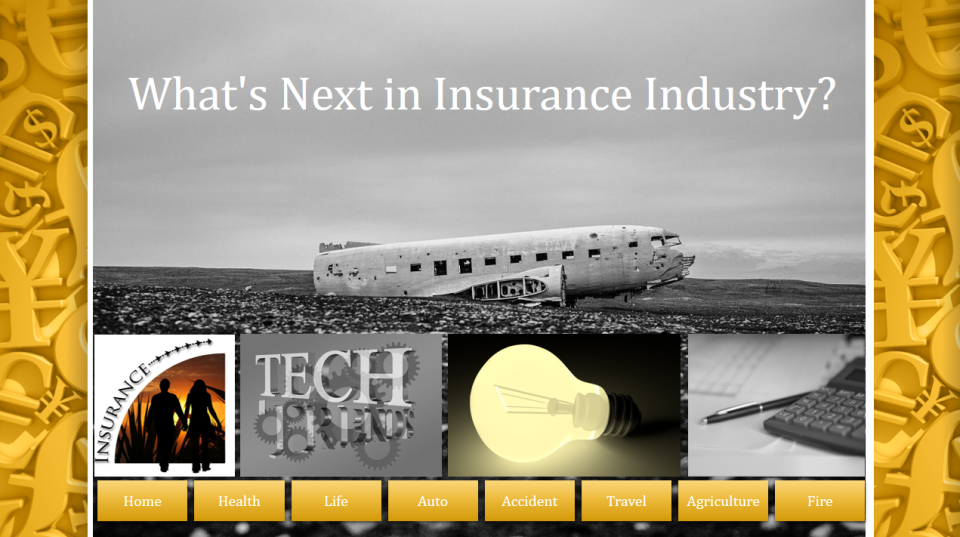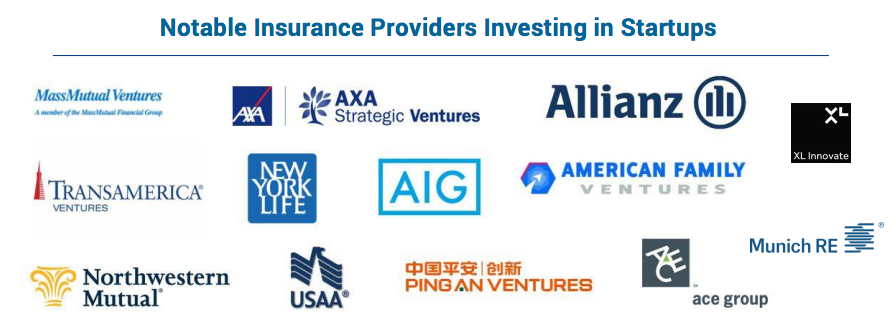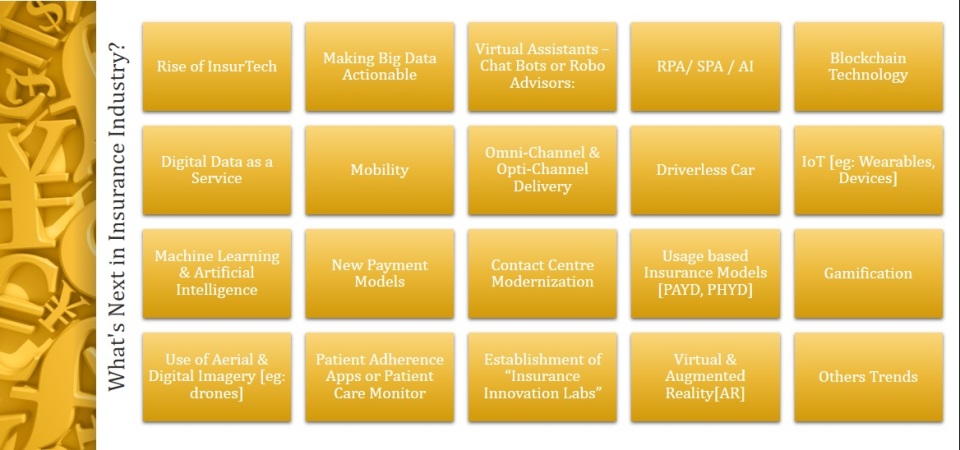Home » Posts tagged 'insurance'
Tag Archives: insurance
Uberization of Insurance Industry!

In recent times, start-ups and disruptive technologies/innovations have set a mandate for all the industries to have a hawk-eye on the market trends and its impact. The veteran and the notable Fortune 500 groups are given tough times by the mushrooming tech giants. Companies can no longer take a back seat and relax.
It is good to be wise and be proud of the experiences & achievements in the past, but most importantly be vigilant of the present and have a defined vision of the future to sustain! and have existence
The technology adoption and re-incarnation of business strategy/priorities to serve the customers will definitely play a crucial role in the Insurance Company’s journey in making it stand tall and strong in the crowd (as a differentiator).
Following are a few highlights of the “Disruptive Trends” the Insurance Industry is trying to adopt for improved Customer Experience[Cx] and reducing Operational Expenditure[OpEx]:
- Rise of InsurTech
- Similar to FinTech organizations, there has been a rise of InsurTech start-ups [leveraging latest technology and innovation] trying to replace or enhance the usage of insurance services of incumbent companies.
- InsurTech solutions bring in an incremental or radical / disruptive innovation development of applications, processes, products or business models in the insurance services industry
- It gives the firms a mix of – Trust built over the years by Insurance Companies & Differentiated experience by newGen Start-ups
- Enables development of Faster Go-To-Market (GTM) solutions than developing age-old legacy systems and maintaining it over time (costly affair)
- Alliance accelerates change and transforms the way to think, develop and satisfy the needs of the customers – will foster more collaborations in the futue
- Making Big Data Actionable
- “Data” is a powerful currency in the race for fintech supremacy.
- In addition to gathering data, making sense and actionable items out of the data heap by leveraging contextual data analytics, intelligence, big data will make a difference for the customers and the financial institution as a whole.
- With enormous data in store, data lake kind of concepts can be adopted and harnessed to reap better benefits
- Machine learning capabilities can be topped-up with the real-time analytics to form the icing on the cake and help in making human-like decisions
- Virtual Assistants – Chat Bots or Robo Advisors:
- It is crucial to understand the customer and suggest products for cross sell/up-sell – based on adaptive(real-time) & predictive(historical) analytics on the transaction/similar transactions for prospective customers
- It is like providing the right product, to the right customer at the right point in time
- g.: similar to Apple’s Siri; Google Now; Amazon’s Echo
- Robotics Process Automation[RPA] / Smart Process Automation[SPA]
- Leveraging RPA / SPA solutions to build Workforce Productivity Solutions [ around areas where there a monotonous, mundane and manual intensive tasks are involved]
- Typical scenarios are: data entry; head-down worker activities; reconciliation process; on-boarding new customers; sending notification/intimation
- This helps in reducing the operational expenditure of the organization and improve the workforce productivity
- Blockchain Technology
- Blockchain technology provides a shared, trusted and secure public ledger to record financial transactions / digital assets and ‘smart contracts’.
- These are recorded independently – distributed across a multitude of computers around the world.
- The records are condensed (into blocks) and interlinked (to form chains), using complex cryptographic algorithms.
- There is no third party required for secured transaction
- The verification of data for primary applicant or reinsurance can be validated by leveraging block chain technology model – this will reduce the complexity and tedious ledger process
- Automated smart contracts can help in quick validation of identity and limited bureaucracy
- Peer-to-Peer Insurance models or Smart Policies can be envisaged[ based on data feed for climatic conditions by Meteorological Dept. pay-outs can be done or initiated for crop/agricultural insurance]
- Key areas where it can be leveraged in Insurance sector:
- Smart Contracts
- Customer Identity Validation / Verification
- Regulatory and Compliance Benefits [Audit]
- Smart Underwriting
- Fraud Management
- Digital Data as a Service [Microservice based model – functional segregation of business]
- Leveraging the Microservices ways of working / implementation to expose some common functionalities and processess as a service
- Few services for example: getting insurance details, capturing policy details, policy payment etc.
- A standard API layer with a SOAP/REST protocol can be can be leveraged to access the functionality from multiple devices / external or other legacy systems
- With this approach – the concentration and focus can only be on the Business Functionality – than building the same functionality for multiple applications / customizing or maintaining it.
- This will help in avoiding development of monolithic application
- It will also give rise to new breed of providers offering data on a subscription model
- Mobility
- Mobility or omni channel experience has already been adopted by some of the major insurance companies
- More personalized and advanced features with a good customer experience will make a difference
- Mobile Health Apps to gather data from the customer and monitor the health – thereby reducing the spending on healthcare and importantly enable insurance companies to understand the customer’s risk profile
- Omni-Channel & Opti-Channel Delivery
- An ‘opti-channel’ experience delivers solutions using the best (optimum) channel based on the customer’s need and preferred channel
- This delivery model is beyond multichannel (delivery on multiple platforms), or Omni channel (delivery through all channels similarly)
- The proliferation of channels will begin to consolidate and improve in efficiencies
- Designing of “Digital Persona” is a key component
- This helps in targeting right customer, at the right time, with the right offer via the right/preferred channel
- Driverless Car [defining new policies]
- With the driverless cars hitting the road – definitely the insurance policy model needs to be revisited [as there will be no human driving it – to claim whose fault]
- Variation based on regional regulatory and compliance will add other dimensions
- For eg: things like black-box in the car similar to ones used in aircrafts can make a difference
- There will be incremental changes to the policies based on the adoption and faith the human race gains over machines
- IoT [eg: Wearables, Devices]
- The Internet of Things’ is becoming a buzzword and the technology trend with repercussions across the business spectrum
- It opens up a new world of opportunities by connecting the internet with billions of devices – wearable gadgets, fancy vehicles, fitness gadgets or industrial equipment
- Sensors, Beacons, Wearables and Devices etc generate humongous amount of data which can be leveraged, aggregated and analyzed by financial institutions to improve operational performance, customer experience, and product pricing
- The dump of data gathered from these devices on a daily basis can be instrumental in defining new services, improve efficiency or achieve other health and safety benefits
- We hear a lot about Smart Home, Fitness Trackers etc. IoT kind of models can be leveraged to optimize and provide customer specific service [house insurance, vehicle insurance or personal health insurance]
- And importantly, with data in hand the Insurance Providers can either help or challenge the customers [eg: in healthcare industry with fitness gadgets]
- With advantages that can be reaped from the data are also associated security, privacy & risk concerns areas
- Leveraging Advanced Machine Learning & Artificial Intelligence
- Machine-based learning is described as the science of getting computers to act without rules-based programming
- Cognitive computing capabilities and development of algorithms that team themselves [self-healing processes] are an integral part leveraging Machine Learning
- The data gathered via IoT [structured + unstructured] can be put to use by crafting ML[Machine Learning] algorithms
- Natural Language Processing – NLP can also be leveraged for providing a more customized / personalized experience
- The Data & Algorithms can help in defining the Digital Persona of the customer
- New Payment Models
- With the ease of regulations, we are back in the era of Money Virtualization
- Every section of the industry food, travel, ecommerce etc. have come up with the Mobile Wallet features – making life easy for the customer to move without carrying cash/coins/cards
- Customers demand powerful services to be delivered at the swipe of a smartphone screen, wherever and whenever they happen to be. As it is delivered in the more efficient way – it is getting easier for them to step over the inertia of the traditional banks
- As many players are entering this space – there is a race for dominance. Insurance Companies can’t walk solo with their offerings, collaborative partnership with mushrooming mobile wallets is the key
- This will help them to : enter competitive market space; save cost; ease of operation; customer demand
- Contact Centre Modernization
- Customer Experience
- Customers are dissatisfied with their customer service experiences
- Better Service
- Providers struggle with critical service and support capability gaps (e.g.: Mobility, outbound emails, personalization etc.)
- Futuristic Platform
- A new generation of “social” customers is setting the agenda for contact centers of the future.
- Competitive Market
- Organizations are taking the first steps toward building next-generation customer management platforms
- Customer Experience
- Usage based Insurance Models [PAYD, PHYD]
- Auto insurers are shifting towards usage-based insurance models that will help them to enhance claims handling capabilities and perform better customer segmentation
- The insurance premium will be calculated based on usage and/or behaviour
- Vehicle Telematics [in car installed devices for sending data at real time] will be leveraged to estimate the usage, driving pattern and driving behaviour
- Some of the models can be;
- PAYD – Pay as You Drive – Insurance premium is calculated based on the number of kilometres/miles coved by the vehicle
- PHYD – Pay how You Drive – Insurance premium is defined based on the driving pattern/style
- Gamification
- Games are a great way to engage the customers across all age groups
- Insurance companies are adopting gamification to simplify the complex and tedious processes – this in turn enhances the Customer Experience, training and adoption
- Gamification uses strategies like points, challenges, leaders board, incentives and different levels of engagement
- It is an integral part of the insurer marketing campaign
- Use of Aerial & Digital Imagery
- Insurers have started using aerial and digital imagery for accessing the property and other relevant details
- This helps in reducing the claims processing time
- Eg.: for a house insurance – aerial and digital imagery can help in getting the exact dimension details, location, proximity to identified risks [if any] – e.g.: seismic zone for earth quakes
- Very helpful for remote locations and primarily for Agriculture based Insurance [for farmers] – Unmanned Aerial Vehicles – UAV [Drones] can be leveraged
- There may be regulatory and compliance challenges which needs to be addressed in case of Drones [to avoid infringement related issues]
- Patient Adherence Apps or Patient Care Monitor
- Non adherence to routine medicine intake or timely check-up might lead to increased healthcare spending for the Customer and at times also hits back to the insurance companies
- With Apps for Care Monitor the patient’s adherence towards medication will improve
- These apps regularly follow-up with the patients for medication, treatment and check-up via games and reminders
- The objective of these apps is to: remind; follow-up; educate; simplify; counsel; reinforce
- The data gathered will be helpful to provide incentives to patients who follow medication regularly and on a timely basis.
- Establishment of “Insurance Innovation Labs”
- The marriage between the traditional insurance and new age start-ups give rise to insurtech “innovation labs” or “digital factory”
- Innovation Labs envision an evolutionary process that re-examine the original purpose of the business (institution) before altering the DNA to redefine the purpose to go beyond the original intent.
- This establishment creates an open space to research, develop and showcase creativity and connect with the customers in enhancing the experience
- This develops a curiosity factor and an experimental approach with the vision of embarking on the digital journey
- The labs can be used to define new opportunities and to test the hypothesis
- It also creates a platform to engage customers with technology / business related discussions, different from the routine transaction related activities
- Insurance Innovation Labs can help in defining:
- Strategic / business thinking – with a focus on business and brand
- Design thinking – product or service creation
- Agile – technological design
- Human / Customer centred design – interface, environment, product design
- Virtual & Augmented Reality[AR]
- The year 2016 was remarkable in terms of the excitement, craze and the impact Virtual & Augmented Reality can bring for any business model [How can we forget Pokemon Go]
- Augmented Reality is a technology that generates sound, video or graphics over real world environment and thereby enhancing the people’s experience.
- Customers are tired of the same marketing models and customer service [ via Contact center call or printed/scanned flyers and brochures]
- VR/AR will be a new space to excite the customers and help them understand the policies/products better
- Customers no longer have to browse through multiple links; flip through multiple pages of the attachments; presume something or spend time in calculating the premium and selecting the right product
- Augmented reality has the potential to bring a paradigm shift in the insurance sector and many of the advanced-thinkers had already started adopting the technology as a major marketing tool.
- Others Trends to watch-out and Adopt
- Leverage Telematics in vehicles to gather data and communicate at real-time
- Connected Health – Stitching the data from wearable and other fitness devices to analyse and recommend the best policy for an individual
- Providing Next-Gen Customer Experience
- Developing Customer Centric Applications (primarily self service enabled – eg: Kiosk)
- Welcome & Leverage Open Source Stacks (OSS)
- Crowd Sourcing Initiatives
- Improvise efficiency and reduce operational expenditure by adopting DevOps

- Original Image Source: Insurance Tech Periodic Table

- Original Image Source : Image
Interesting Read Articles & References:
- 5 Insurance Companies that found a novel way for marketing [Virtual & Augmented Reality]
- Block Chain in insurance – Opportunity or Threat [McKinsey]
- Some use-cases of Blockchain in Insurance
- Blockchain in Insurance Sector
- McKinsey Report Weighs Blockchain Impact on Insurance Industry
- Trends in Insurance Tech
- Top trends in Insurance – 2016
- Insight Insurance Tech Vision
- Insurance Industry Trends
- BPM software spend to hit 2.7bn
- ‘You won’t need insurance for self-driving cars’
- Wearable Technology data to aid premium calculation
- Dashboard footage now accepted insurance disputes in UK
- InsurTek Insights
- Insurers use drones for crop and agricultural insurance
- 5 ways IoT will transform the Insurance Industry
- Insur Tech – Startups
- 16 Insur Tech Start-ups to watch-out
- Disruption in the insurance industry: Displacement or innovation?
- How Technology is quickly disrupting the Insurance Industry
- Big Bang Digital Disruption: Is the insurance industry in Asia next?
Keep Reading, Keep Researching & Keep Blogging!!
Please do share your thoughts and views to enrich it!
Happy Reading! 🙂
Disclaimer: Views my OWN not my Employer’s
[The intent of using the images was to pictorially share the thoughts and share the learning. Happy to share Credits for the photos and images]
Related posts: [old blogs]


